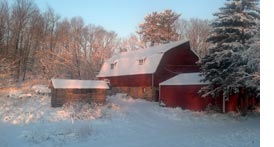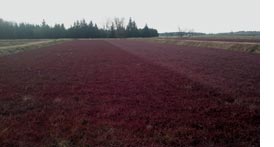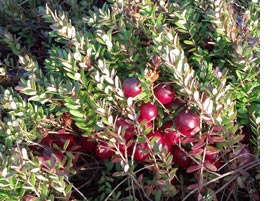 Have you ever been browsing in an antique store and found a wooden box with rakish teeth on it? It could be a hand cranberry rake, a farm implement of yore. Possibly the same kind that farmer Brian Ruesch of Ruesch Century Farm uses today on his tiny organic cranberry farm.
Have you ever been browsing in an antique store and found a wooden box with rakish teeth on it? It could be a hand cranberry rake, a farm implement of yore. Possibly the same kind that farmer Brian Ruesch of Ruesch Century Farm uses today on his tiny organic cranberry farm.
Brian calls his Vesper, Wisconsin farm the “world’s smallest organic cranberry bog” and it may be at only one acre. Hand harvesting also sets Brian apart from most other cranberry farms, which generally flood their fields and use mechanical harvesters. Brian uses the same cranberry rake his ancestors did: it looks like a picnic basket with teeth in front and was designed 130 years ago. To use the rake, Brian swings it over the low-lying vines and scoops off the berries. “Its back-breaking work,” says Brian, and makes for a slow harvest, but the hand harvest translates into sweet and long-lasting cranberries, unbruised by machines.
The Ruesch family has been operating their farm for well over a century. Brian’s family bought it in 1879 and raised dairy and tapped trees for maple syrup. In the 1990s, his father dug a small pond to put in cranberries and made the important decision to grow organically. Brian has continued his father’s work.
Want farm-fresh fruit?
We've got you covered.

Ruesch farm is certified organic by the Midwest Organic Services Association. Wetlands have traditionally been used for cranberry farming but Brian grows cranberries upland, to preserve marsh habitat. Secondly Brian does not use insecticide; instead, he floods the bogs in summer to protect the vines from pests.
“Rather than pesticides to kill insects and herbicides to kill grass, we employ natural methods to keep the grass under control and ”to kill the black-headed fire-worm and cranberry fruit worm (flooding in late May for BHFW). Flooding suppresses weed growth and kills fruit worm eggs,” said Brian, on the farm website. “Yields are not high, especially at first. There is more work, but also satisfaction in knowing that you have raised a crop of fruit that has not been chemically touched in any way. Since it is a small marsh, the tools we use are limited to a mechanical cranberry rake (and knuckle grease), so you get berries off the vines without flooding first.”

You may have seen images of crimson ponds of cranberries with harvesters in hip boots. Cranberries are wetland plants but they do not grow underwater. Cranberries are harvested either “wet” or “dry,” depending on their end-use. Berries that will end up as juice or sauce are “wet harvested,” a technique in which fields of cranberry vines are flooded with about 10 inches of water. A harvesting machine then moves through and shakes the vines and the berries float to the surface where they are corralled into sorting machines. The cranberry fruit has four hollow air pockets inside which gives it buoyancy. Yet during a water harvest, those pockets may fill and reduce its shelf life compared to dry-harvested berries. Berries sold fresh are dry harvested, usually with a mechanical harvester. But Brian dry harvests by hand, further reducing the chance of berry damage and earlier spoilage.
 “People tell me my cranberries have lasted for weeks!” Brian says proudly.
“People tell me my cranberries have lasted for weeks!” Brian says proudly.
Wisconsin is the largest producer of cranberries in the U.S., producing 57% of the 2011 crop, which was worth more than $344 million, according to the National Agricultural Statistics Service. Smack dab in the middle of the state is Wood County, where the Ruesch farm is, the state’s prime cranberry growing region due to the acidic sandy soil of an ancient lakebed. Cranberries are one of few truly native fruits to the U.S. Native Americans preserved them as a winter source of fruit and used them as medicine and for dye. They also showed early settlers how to harvest and use this powerful berry. Settlers cut channels in marshes next to groves of cranberry bushes and developed more cultivation techniques.
 “Sanding” is a cranberry cultivation technique that was brought west from Massachusetts, another strong cranberry growing region. When the Wisconsin winter sets in and, as Brian says, “It gets cold enough for the plants to go dormant, including people,” he covers the cranberry bog in water, which freezes into ice. When the ice is hard enough to drive on they spread sand on top. Come spring thaw, the plants have a layer of sand to grab onto to come up out of the ice. Henry Hall invented sanding in 1816 after noticing improved cranberries where the Cape Cod sand dunes blew over wintering plants.
“Sanding” is a cranberry cultivation technique that was brought west from Massachusetts, another strong cranberry growing region. When the Wisconsin winter sets in and, as Brian says, “It gets cold enough for the plants to go dormant, including people,” he covers the cranberry bog in water, which freezes into ice. When the ice is hard enough to drive on they spread sand on top. Come spring thaw, the plants have a layer of sand to grab onto to come up out of the ice. Henry Hall invented sanding in 1816 after noticing improved cranberries where the Cape Cod sand dunes blew over wintering plants.
Fresh whole cranberries are full of Vitamin C, fiber, and manganese, but also contain an array of phytonutrients that have been studied for anti-inflammatory, anti-bacterial, anti-cancer, and antioxidant effects. Consumption may help prevent recurring urinary tract infections and potentially stomach ulcers according to BBC Good Food.
"*" indicates required fields
Take advantage of faster checkouts and other great benefits.
Create an AccountWe are here to help you provide healthy food, meaning, and a reason to gather in your workplace.
From weekly mixed fruit for break rooms to monthly gifts for remote staff to special projects, we can serve your needs or turn your dreams into a nourishing reality.
Get your weekly dose of the latest fruit info and exclusive updates.
"*" indicates required fields

